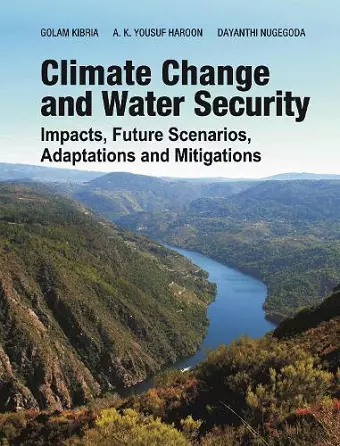Climate Change and Water Security
Impacts, Future Scenarios, Adaptations and Mitigations
Golam Kibria author Dayanthi Nugegoda author A K Yousuf Haroon author
Format:Paperback
Publisher:New India Publishing Agency
Published:31st May '16
Currently unavailable, and unfortunately no date known when it will be back
This paperback is available in another edition too:
- Hardback£177.00(9789385516269)

The book is an attempt to address the important facts and figures relating to climate change impacts on water security: a. Climate change impacts on water resources; b. Climate change impacts on water related diseases; c. Climate change impacts on water dependent biodiversity and ecosystems; d. Climate change adaptation and mitigation measures for water security; and e. Climate change and greenhouse gas emissions from water sector.
- Climate change is an additional stress on water security in addition to other chemical and biological stressors.
- Rivers depending on the Himalayan glaciers (the Indus, Ganges, Brahmaputra) could face water shortages or reduced river run-off due to retreat of glaciers, and this would cause dramatic impact on drinking water supplies, biodiversity, hydropower generation, industry, agriculture, ecosystems on which about 2.4 billion people in Asia depends.
- As a consequence of drought, the annual stream flow in the Murray-Darling basin (Australia) is projected to fall by 10-25% by 2050 and 16-48% by 2100 which would have severe consequences on irrigated agriculture in the region.
- Rise of water temperatures may enhance proliferation of harmful algae (some of algae produce toxins), causing water quality problems for recreational activities, fisheries/fish farming, irrigation, and drinking and seafood contamination with algal toxins.
- Global warming is projected to increase river water temperatures in a number of countries including the USA (the Mississippi, Colorado, and Mackenzie basins), Europe (the Rhine, Danube, and Rhone basins), eastern China (the Yangtze), and Australia (the Murray-Darling).
- Sea-level rise (SLR) will cause salinization of coastal groundwater resources, and may damage or destroy many coastal ecosystems including wetlands, salt marshes, and may cause saline water intrusion in agriculture and freshwater aquaculture facilities, a shift in community composition of mangrove forests, etc.
- It is projected that a 1°C rise of temperature in the future can increase the initial relative risks of cholera by 15 to 29 percent. Both rise of temperature and sea-level may enhance dengue and malaria.
- To adapt to climate change, we need increasing storage capacity, rainwater harvesting, improvement of water use efficiency, desalination of seawater, water savings, mandatory rainwater tanks in new and old buildings, use of recycled/reclaimed water, virtual water trade, improvements in irrigation efficiency, modification of irrigation techniques, reducing leakage of irrigation pipes, selection of climate resilient crops to save scarcity of water resources.
- Water processes (abstraction, treatment,...
ISBN: 9788119072446
Dimensions: unknown
Weight: 1040g
314 pages